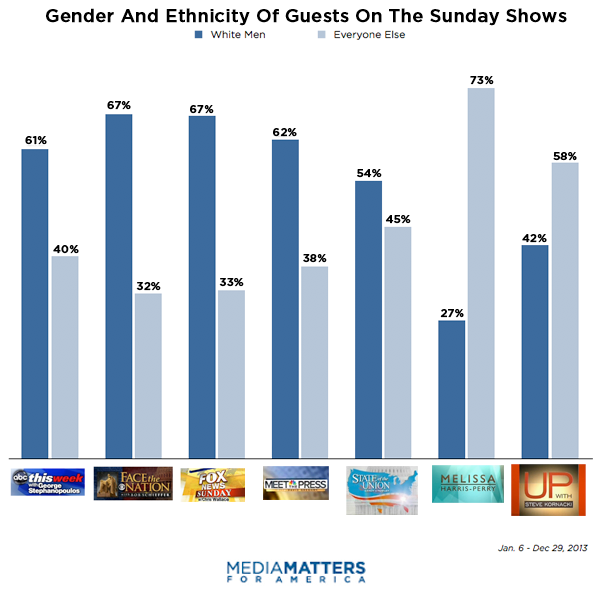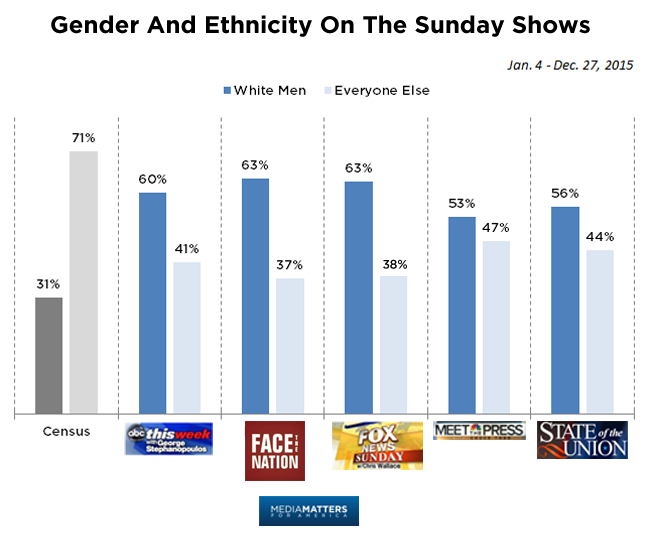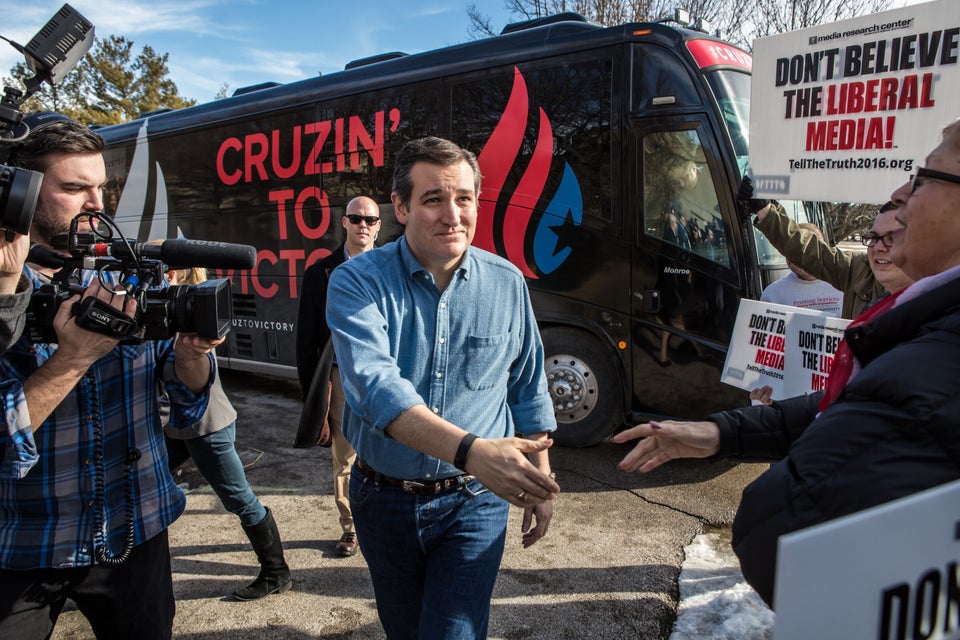Melissa Harris-Perry was at 30 Rockefeller Center prepping for her MSNBC show last month when she witnessed the taping of an all-white panel of journalists and analysts discussing black voters in South Carolina.
“It was jaw-dropping," Harris-Perry said in a New York Times interview back in March. "Given that someone who wrote two books about the black vote was in the building."
Her experience, and her recent departure from MSNBC, is emblematic of a deeper problem in cable news: people of color not being included in conversations about people of color. Outside of MSNBC lies a whole cable news landscape that severely lacks inclusion, and the timing is terrible.
In an election year where people of color account for 43 percent of eligible voters, where the Latino electorate alone will reach 27 million people, where white men make up a mere 31 percent of the American population, why is it that when the "black vote" and "Latino" are up for debate on TV, black and Latino voices are either tokenized, or worse -- simply not there?
Watch a mashup of discussions about the "black vote" on cable news below:
MSNBC was thrown into controversy after it had a very messy and very public falling out with Harris-Perry last month. In a leaked email to her staff, she claimed that the network had tried to stifle her voice and authority. They pushed her away from conducting cultural discussions about race and identity and encouraged her to give a more straightforward analysis of the election, she said -- something she had no interest in doing.
"I am not a token, mammy or little brown bobble head," Harris-Perry wrote. "I am not owned by... MSNBC."
“"I am not a token, mammy or little brown bobble head."”
- Melissa Harris-Perry
The fallout from the whole episode prompted many to criticize not just MSNBC's alleged unfair treatment of Harris-Perry, but the network's lack of diversity overall. Since last year, the network has had a complete editorial overhaul, which meant the cancellation of most of its op-ed styles shows, including Ronan Farrow's millennial-focused "Ronan Farrow Daily," and Joy Reid's "The Reid Report."
But also among the shows axed were daily editorial news hours hosted by Alex Wagner, Touré, and Rev. Al Sharpton (whose show now only airs on Sundays), all moves that have prompted outcry and criticism. With Harris-Perry, Reid and Wagner gone, the only woman of color hosting a show on the network is Tamron Hall.
Meanwhile, Cuban-American journalist Jose Diaz-Balart (who also anchors news hours on Telemundo and NBC), has seen his early-morning hour on MSNBC frequently-bumped to make room for election coverage and "Morning Joe."
Other than news anchors who report daily news, there are currently zero editorial or op-ed style shows (in the vein of Rachel Maddow or Bill O'Reilly) hosted by a person of color on the major cable news networks: MSNBC, CNN, and Fox News. And with Harris-Perry's show gone, there are certainly far fewer diverse perspectives represented.
"[Harris-Perry] gave so many people their first shot," trans activist and Melissa Harris-Perry Show guest Cherno Biko told The Huffington Post. "She gave marginalized people a seat at the table."
A 2014 Media Matters study found that Harris-Perry's show, compared to other Sunday shows including "Meet the Press" and "Fox News Sunday," had the most diverse guests based on race and gender, with 27 percent white male guests and 73 percent of men and women of color.
2014 Media Matters Breakdown Of Sunday Shows Guests Based And Gender And Ethnicity:

Here are some unsurprising, but alarming truths about the state of of cable news: A 2014 FAIR report found that 84 percent of cable news guests were white, the majority of them male. Last year, Vocativ researched not just the Sunday news shows, but all primetime and morning shows across the major networks, finding that people of color made up just 30 percent of all hosts and anchors (women of color were the least represented).
Beyond field reporters and contributors, there are only a handful of anchors or hosts of color on the major cable news networks: Tamron Hall, Craig Melvin, Jose Diaz-Albert, and Frances Rivera on MSNBC; Victor Blackwell, Michaela Pereira, Fredricka Whitfield and Don Lemon on CNN.
CNN has also received criticism in the past for apparently phasing out black executives and prominent personalities including Suzanne Malveaux, Soledad O'Brien and TJ Holmes. The network, in a statement to The Huffington Post, CNN's Vice President of Diversity and Inclusion Geraldine Moriba maintains that it is very committed to diversity and inclusion, saying, "We aim to provide different points of view and perspective in our news gathering and reporting."
Meanwhile, Fox News has three black anchors (Charles Payne, Arthel Neville and Harris Faulkner), two co-anchors (Kelly Wright and Charles Payne) but very few black contributors. A Media Matters annual "Sunday Shows" study revealed this year that 86 percent of guests on Fox News Sunday were white, and 63 percent were white men.
We are in an election year, and we're witnessing one of the most bizarre, frightening, fascinating, and important presidential races in recent memory. Discussions in particular about race have reached a boiling point -- between the incidents of police brutality across the nation, the water crises in city's like Flint, and the often incendiary racial and xenophobic comments of a certain Republican candidate, race is at the forefront of the country's collective mind.
Cable news is where many Americans go to unpack these issues. So what does it mean when, across the breadth of the cable news world, white anchors (be they on liberal or conservative networks) are bringing us that news, and shaping that conversation?
While some networks make an effort to have at least one black or brown voice at the table, just as often the analysts, pundits, and hosts leading these discussions are white. The ramifications of this could be harmless, or they could be damaging. Take, for example, CNN's 2015 coverage of the protests in Baltimore in the wake of the killing of Freddie Gray, where much of the emphasis of the coverage was on subtlety condemning the protestors as looters and thugs, rather than questioning why they were moved to protest in the first place.
"Good journalism... tries to understand why a city is bleeding instead of just frowning at the wound," Slate writer Justin Peters aptly observed.
And in an election year where immigration is also a hot button topic, there is a dearth of Latino representation across the networks which has been the case for years.
2015 Media Matters Breakdown Of Sunday Shows Guests Based And Gender And Ethnicity:

"Diversity isn't just about inviting minorities to discuss issues of race," says Cherno Biko. "Our opinions should be included for topics that run the gamut."
There are some realities to acknowledge when it comes to this topic. First: the fact that MSNBC, a historically liberal network, saw its low ratings begin to perk up when it began focusing on the election and straightforward news and started phasing out its op-ed style shows (then again, it isn't surprising that ratings would rise during an election year).
Also, statistics show that cable news watchers are overwhelmingly white, male, and middle-aged to senior citizens. Do these viewers really care about diversity among their anchors? Are young, black and Latino voters really getting their news about the campaign from Fox, CNN, and MSNBC, or are they finding it on social media platforms? After all, a 2015 American Press Institute survey found that a whopping 88 percent of millennials say they get their news from Facebook.
“"Diversity is an ongoing, everyday process. It is not a one and done. It is also dependent on the content. That's also diversity. "”
- Yvette Miley, MSNBC
But for Yvette Miley, the Senior Vice President of Talent And Diversity at MSNBC, the aim of all networks should be to reach as diverse an array of viewers as possible. The network is keen to emphasize the fact that while they have no editorial shows hosted by people of color, they have ongoing relationships with people like Joy-Ann Reid, and a racially diverse roster of contributors. In addition to focusing on their pipeline programs and hiring people of color in positions of power behind-the-scenes (like Rashida Jones, the managing editor for MSNBC), Miley says that the network is addressing inclusion through other channels.
"Diversity is an ongoing, everyday process," she told The Huffington Post. "It is not a one and done. It is also dependent on the content. That's also diversity. "
Miley brings up a valid point -- the concept of diversity, especially as it pertains to cable news, is not finite. The Melissa Harris-Perry's of the world are equally as important as the Yvette Miley's, as the Rashida Jones'. There are just 10 black-owned media stations in the United States, a fact that makes the dearth of black primetime anchors in news even less surprising.
While MSNBC seems to be making a concerted effort to prove the #MSNBCsoWhite criticism wrong, it remains unclear whether other major networks share the same apparent passion for diversity.
The problem of diversity in cable news, then, is a many-headed monster. Will more black guests across cable news fix the issue? Or more black anchors? Or more POC producers, vice presidents, and executive editors? At what point does representation become a non-issue in journalism? Should the race of who is leading conversations really affect the conversation itself?
There are people behind-the-scenes who believe that the race of those having conversations about issues affecting black people is totally irrelevant -- it's journalism after all, and journalism isn't about bias.
On the other hand, studies have shown that racial bias in news media is an ongoing issue. That's why perspective and context is an important aspect of even the most straightforward reporting. A white Fox News host who refuses to acknowledge race as a factor in the police killing of a black man, with no one there to vigorously challenge or even question him, is a perfect example of this.
When talking about the need for more black hosts on cable news, one must return to the image of Melissa Harris-Perry listening to Steve Kornacki lead a vigorous debate with Kate Snow and Ari Melber about the "black vote." Suddenly, the only question that seems worth asking is: how can race not be relevant?
*As of publishing this article, Fox News has yet to comment. This post has been updated with a comment from CNN.

